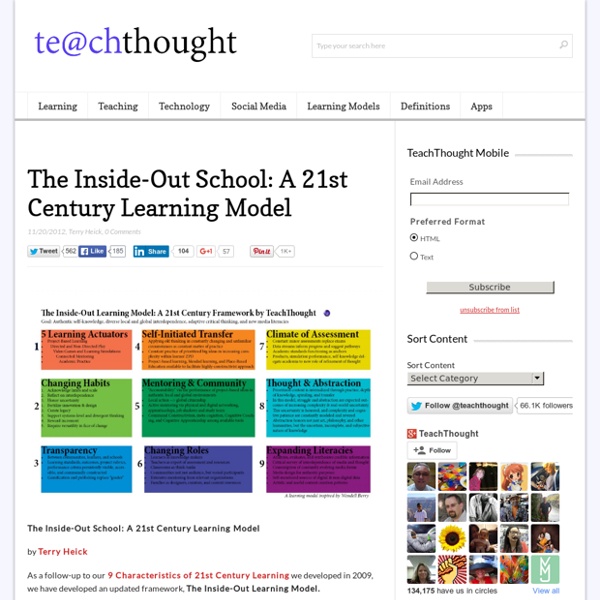21st Century Educator
Listen to the two songs linked below, and ask yourself, is this the message we should be sending our children? After the horrible rape case in the now infamous town of Steubenville, I have been thinking about what could possibly have made this act seem justified by the boys who committed it, and although I do not think we can lay all of the blame on popular media, as it is a reflection of our culture, some of the blame must lie there. I listened to this song, at the request of my son, and I was quickly horrified.
9 Characteristics Of 21st Century Learning
The label of “21st Century learning” is vague, and is an idea that we here at TeachThought like to take a swing at as often as possible, including: –weighing the magic of technology with its incredible cost and complexity –underscoring the potential for well thought-out instructional design –considering the considerable potential of social media platforms against its apparent divergence from academic learning Some educators seek out the ideal of a 21st century learning environment constantly, while others prefer that we lose the phrase altogether, insisting that learning hasn’t changed, and good learning looks the same whether it’s the 12th or 21st century. At TeachThought, we tend towards the tech-infused model, but do spend time exploring the limits and challenges of technology, the impact of rapid technology change, and carefully considering important questions before diving in head-first.
Is Google Making Us Stupid?
Illustration by Guy Billout "Dave, stop. Stop, will you? Stop, Dave. Will you stop, Dave?” So the supercomputer HAL pleads with the implacable astronaut Dave Bowman in a famous and weirdly poignant scene toward the end of Stanley Kubrick’s 2001: A Space Odyssey.
4 Phases of Inquiry-Based Learning: A Guide For Teachers
According to Indiana University Bloomington, Inquiry-based learning is an “instructional model that centers learning on a solving a particular problem or answering a central question. There are several different inquiry-based learning models, but most have several general elements in common: Learning focuses around a meaningful, ill-structured problem that demands consideration of diverse perspectivesAcademic content-learning occurs as a natural part of the process as students work towards finding solutionsLearners, working collaboratively, assume an active role in the learning processTeachers provide learners with learning supports and rich multiple media sources of information to assist students in successfully finding solutionsLearners share and defend solutions publicly in some manner”
Information Fluency
Information Fluency According to Danny Callison, information fluency is the ability to apply the skills associated with information literacy, computer literacy and critical thinking to address and solve information problems across disciplines, across academic levels, and across information format structures. According to The Associated Colleges of the South ( using critical thinking skills and appropriate technologies, information fluency integrates the abilities to: collect the information necessary to consider a problem or issue employ critical thinking skills in the evaluation and analysis of the information and its sources formulate logical conclusions and present those conclusions in an appropriate and effective way
PSA: Please Stop Saying '21st Century Education'
If you ever find yourself sitting in a meeting—or listening to a politician's speech—about education reform, it's pretty much guaranteed that you'll hear mention of how schools need to ensure kids are "21st century learners," who are acquiring "21st century skills," in a "21st century classroom." But in the thirteenth year of the 21st century, what does any of this "21st century education" talk mean—and is it even happening? Last September, educator and author Grant Lichtman set out on a quest to discover the answer.
7 Ed Tech Trends to Watch in 2014
Technology trends in both higher ed and K-12 classrooms continue to evolve and transform traditional learning environments. New learning analytics, mobile devices, open online learning, and 3D printers are some of the many Educational technology trends to be on the lookout for in 2014. Here’s a detailed discussion. 1) 3D Printing
Documentary 'Print the Legend' Goes Inside the World of 3D Printing
The genesis of and challenges to the 3D-printing revolution are subjects that take center stage in a new documentary called Print the Legend. From directors Clay Tweel and Luis Lopez (Freakonomics), the film sets out to act as a "'time capsule' of a nascent industry," Tweel told Mashable. "The result is both a look inside a compelling new technology, and hopefully, a story about the challenges of growing any type of business, and facing the moral dilemmas our marketplace presents."
The Challenges and Realities of Inquiry-Based Learning
Inquiry Learning Teaching Strategies Getty By Thom Markham Teachers in a rural southeast Michigan high school were recently discussing the odd behavior of the senior class. It seems the 12th graders were acting more civilly toward the junior class in the hallways. The prom was also quieter and more well-mannered than in previous years.
How Google Impacts The Way Students Think
How Google Impacts The Way Students Think by Terry Heick It’s always revealing to watch learners research.
Math, PBL and 21st Century Learning for All Students
Considering project-based learning as a way to teach 21st century competencies? Or perhaps you have already used PBL in your schools and want support for your discussions with administrators, parents or board members? In either case, it might be helpful to know about the strong research evidence that PBL, when supported by good professional development, can in turn support the teaching and learning of 21st century skills significantly better than more traditional alternatives.



